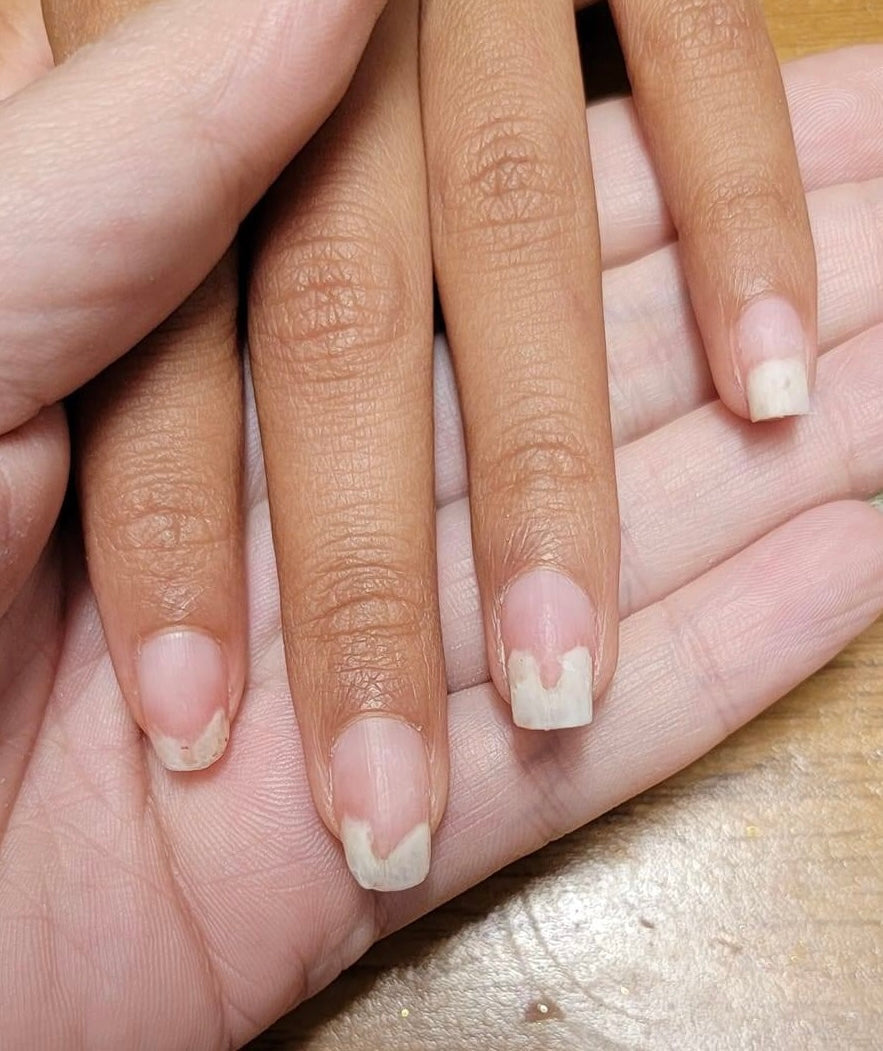
Nail Diseases: 7 Symptoms, Causes, and Treatments You Should Know
Common nail diseases that are important to know about as a nail therapist
As a nail therapist, you work not only to create beautiful nails, but also to maintain and promote the health of your clients' nails. Therefore, it is important to have knowledge of common nail diseases and how they can affect your clients. A knowledgeable nail therapist can identify potential problems and advise on how the client can get professional help if needed. Here are some of the most common nail diseases that you should be aware of.
Read more about important precautions for nail therapists – learn what you should keep in mind to ensure safe and effective treatments!
1. Onychomycosis (nail fungus)
Nail fungus is a very common infection that often affects the toenails, but can also occur on fingernails. Symptoms include:
- Thickened nails
- Discoloration, often yellow or brownish
- Brittle or crumbling edges
- A nail that is starting to separate from the nail bed
Nail fungus is caused by dermatophytes, a type of fungus that thrives in warm, moist environments. As a nail therapist, it is important to recognize the signs of nail fungus and recommend that the client seek medical treatment, as the fungus cannot be treated with regular nail products. Working on an infected nail without proper precautions can also spread the infection to other nails or clients.
2. Paronychia (cuticle infection)
Paronychia is an infection of the cuticle that is often caused by bacteria, but can also be caused by fungus. Common symptoms include:
- Redness and swelling around the cuticle
- Pain and tenderness
- Pustule formation
This infection can occur after damage to the cuticles, such as when trimming or cutting too much of the cuticle. Therefore, it is important to be careful when working close to the client's cuticles. A mild infection can often heal with proper care, but more severe cases may require treatment with antibiotics or other medications.
3. Onycholysis (separation of the nail from the nail bed)
Onycholysis means that the nail begins to separate from its nail bed. It can start at the tip of the nail and gradually spread. This can have several causes:
- Injury or trauma to the nail (e.g. bumps or pinching)
- Reaction to chemicals or products used in nail care
- Fungal or bacterial infections
- Underlying health problems such as psoriasis or thyroid disease
As a nail therapist, you should be aware that stress or overuse of products can worsen onycholysis. If a client has this problem, you should avoid harsh chemicals and recommend that the client take a break from nail treatments until the nail has healed.
4. Psoriasis
Psoriasis is an autoimmune disease that affects the skin and can also affect the nails. Symptoms of nail psoriasis include:
- Dimples or pits in the nail plate
- Thickening and discoloration of the nail
- Onycholysis, where the nail separates from the nail bed
- White or yellow spots or calluses under the nail
Nail psoriasis can sometimes be mistaken for nail fungus, but is caused by the body's immune system. As a nail therapist, it is important to understand that nail psoriasis is not contagious, but that you should be careful when treating affected nails. Clients with nail psoriasis may have fragile nails, and it is important to use gentler products and techniques to avoid further damage. Always recommend that the client consult a doctor before starting nail treatments, to ensure that you as a nail therapist do not cause harm.
5. Onychorrhexis (brittle nails)
Onychorrhexis is a condition in which the nails become dry, brittle, and brittle. This can be caused by:
- Aging
- Frequent exposure to water or chemicals
- Vitamin deficiency or other nutritional problems
- Underlying medical conditions such as thyroid problems or eczema
As a nail therapist, it is important to identify brittle nails and adapt treatment accordingly. You can recommend strengthening nail products, advise on home nail care, and avoid treatments that can further dry out nails, such as excessive use of acetone.
6. Melanonychia (dark streaks on the nails)
Melanonychia means having dark streaks or lines on your nails. It can be caused by an increase in the pigment melanin and can have several causes:
- Trauma to the nail
- Certain medications
- Hereditary factors
However, in some cases, melanonychia can be a sign of something more serious, such as skin cancer (e.g., melanoma under the nail). If you see dark, irregular streaks on your client's nails that don't seem to have an obvious cause, you should recommend that they see a doctor for further evaluation.
7. Koilonychia (spoon-shaped nails)
Koilonychia, also known as "spoon nails," is a condition in which the nails become concave and take on a spoon-like shape. This can be a sign of:
- Iron deficiency
- Anemia
- Underlying health problems such as heart disease or thyroid disorders
As a nail therapist, you should be aware that this may indicate a medical condition and advise that the client may need to have it examined by a doctor.

